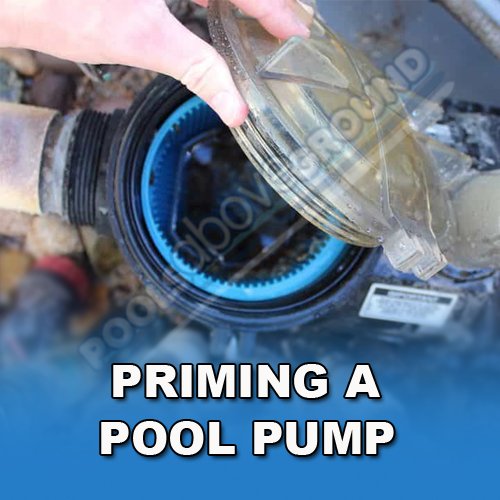How To Prime A Pool Pump
In order for your pool system to run properly, all of the air must be removed from the pump, filter tank and plumbing in order for the water to circulate correctly and efficiently. This isn’t much of a problem with above ground pools because the pump typically is lower than the water level and is naturally primed by gravity. This simply means the water runs down hill to the head of the pump and there is always water ready for uptake by the pump. On inground pools and some semi inground or above ground pools where the pump is higher than the water’s surface there is no gravity to prime the pump. In these situations an in-ground pool pump will be necessary to operate properly, otherwise you’ll be priming it daily.
Priming the pump is the process of removing all of the air from the system, so only water is cycling through. Should you fail to do this or let your pump run without water, the heat caused by the excess air (and lack of water) can end up damaging the pump and the associated equipment. This can ultimately keep the water from circulating.
Check Your Pool’s Water Level
Probably one of the biggest causes of air in the system and poor water circulation is a pool with not enough water in it. Once the water level is too low the pump will begin to suck in air along with the water and pool circulation will begin. It will continue to get worse until water is added to the pool. Check your water level frequently. If you see bubble going back into the pool your water level may be low.
Turn Off The Pool Pump
If you find your pump is dry and needing to be primed here are a few simple steps to be up and running again. The first step before doing any work on your pool system is to turn everything off. This includes salt units, ozonators, timers etc. You don’t have to unplug the system or cut the breaker, but you do want the pump to be in the off position to keep yourself from being sprayed.
Remove Lid and Clean
The next step is to remove the lid on top of the pump by turning it counterclockwise. If the pump and or skimmer basket are full of leaves and other debris, now is a great time to clean them out. If you must, spray the basket down with a hose to remove any grit or clumps of dirt clinging to the lining.While your at it look for cracked or broke pipes that might be an issue.
Use A Hose To Fill Pump
I recommend going ahead and opening the air release valve now if you have one. This is one of the places where air will be forced out of the system, and it will spray water when that portion of the system is primed. Using a hose, fill up the pump basket area with water. The lines running to and from the pool will also start to flood with water. Once you filled as much as it’ll take replace the lid properly.
Run the Pump
Now is a good time to double-check that the air release valve, the return lines, and the suction lines are all open. You don’t want any plugs in the pool or other pockets where air could become trapped. Now turn the system on. You will hear a “vacuum” sound as air is forced out of the piping. Once the air release valve starts spraying water, go ahead and close it. This will force the remaining air out via the pool return lines. The system will make noise and bubble, that’s normal. Once all the air is removed from the system things should calm down and the bubbles should cease. There should only be a strong steady stream of water coming for the pool’s return jet.
Return To Normal Operations
If all is well and there are no obvious problem to deal with, turning on the salt unit and any other systems should be a go. If you have to repeat these steps or are mystified as to why you had to do them in the first place, it’s time to look for blocked lines, cracked or leaking suction line, bad lid gasket or other causes as to why your pump loses prime when turned off.
We’ll dig more into the causes of this issue in another blog post. Happy Swimming from http://lakelandabovegroundpools.com/!!


